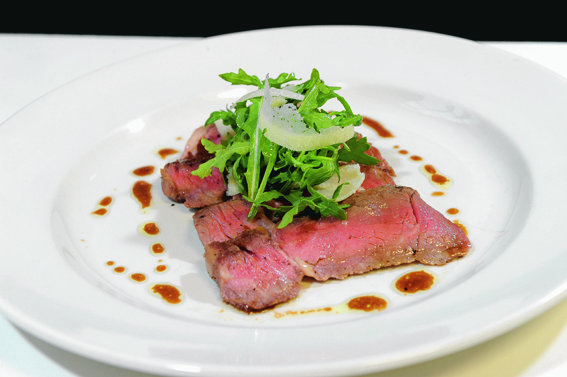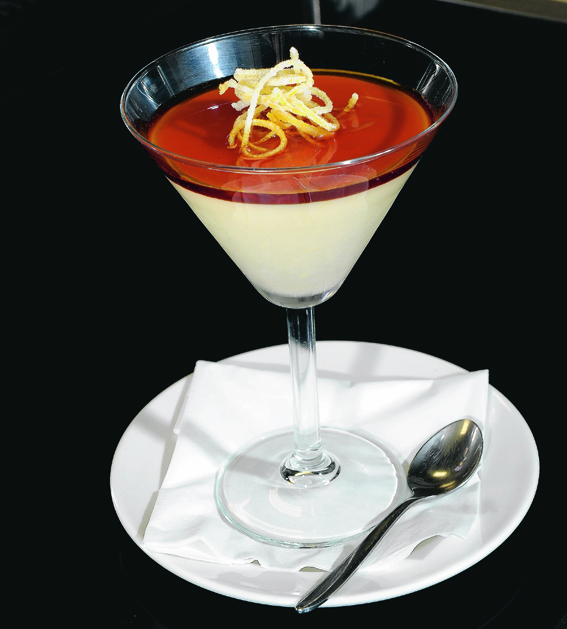Award-winning chef Nick Nairn reveals how to make the perfect steak – the ideal weekend treat and a nice alternative to festive fare
Classes showing people how to cook the perfect steak have become the most popular course we run at the Cook School in Aberdeen by a country mile. The school has been a fantastic success and it’s an absolute joy to visit.
I’m delighted that so many people now know how to cook steak well as some of the best meat in the planet comes from the Grampian area. We go through about 500 steaks a week, all from Davidsons of Inverurie.
Having a steak on a Friday night is a great way to start the weekend. Buy the best quality meat you can afford, and remember to take the steak out of the fridge about an hour before you plan to cook it as this allows it to come up to room temperature.
When frying it’s very important to get your pan to the right temperature first. A good way to tell if your pan is too cold is to listen, it will be making barely a sizzle. If your pan is too hot, then the oil will sizzle and spit violently, and may start to haze.
If you get your pan to just the right temperature, you should be able to hold your hand over the pan and feel a radiant heat, like the dying embers of a fire. When the oil and the produce go in, they’ll make a nice sizzling sound, and when heated like this, your pan will help you to achieve the perfect caramelised crust on your steak.
To follow the steak tuck into lemon posset. This has got to be one of the easiest desserts on the planet as it has just three ingredients, lemon, sugar and cream. It takes five minutes to make but tastes sensational. It can be made ahead and served cold, straight from the fridge.
THE PERFECT STEAK: MALBEC-GLAZED ABERDEEN ANGUS STEAK
SERVES 1
 1 dry aged sirloin steak, weighing about 170g-225g (6-8oz)
1 dry aged sirloin steak, weighing about 170g-225g (6-8oz)
Maldon sea salt
2tbsp sunflower oil
20g butter
50ml Malbec red wine
60ml chicken and beef stock
Remove the steak from the fridge and bring up to room temperature before you begin. Season with salt. Heat a large frying pan until happy. Add the oil and heat then add the steak. Sear until you’ve got a good crust, and don’t move the meat about. If you fiddle with the steak while it’s cooking, the crust may fall off and stick to the pan. When a good colour has been achieved on the base, turn the steak over and leave once more to caramelise. So far, the cooking time will have been about a minute each side, depending on the size of the steak. Make sure the whole surface has plenty of colour and the edges are well sealed – you may need to hold it on its side to achieve this.
Reduce the heat slightly, add the butter and allow to colour a little. Butter can’t stand high temperatures for long, so don’t let it burn. Allow the steak to cook for another minute or so each side. During this phase of cooking, probe the steak to check its core temperature, and remove from the pan when you hit the temperature you’re aiming for. The cooking time shouldn’t be more than about five minutes for a medium rare steak of this size.
Transfer the steaks to a baking tray and leave in a warm place to relax. This is a vital process, as when the meat cooks, the fibres shrink and force all the juices to the centre. Leaving the meat to relax will allow the juices to redistribute, making the meat tender and succulent. Pour any excess fat left in the pan over the meat as it rests. Add the wine to the pan over a high heat for one minute to boil off the alcohol. Add the stock and reduce until it forms a thick glaze. Use a heat-proof spatula to scrape and stir up any caramelised pieces stuck to the bottom. When the sauce is thick and well reduced, pour in any further juices from the resting meat and stir.
To serve diagonally slice the rested steaks, place on a warm plate and spoon over the sauce. Serve with potatoes and a green salad.
NICK’S LEMON POSSET WITH ORANGE CARAMEL
SERVES 2
Zest and juice of 1 large juicy lemon, unwaxed
75g caster sugar
300ml double cream
FOR THE CARAMEL
200g castor sugar
75ml orange juice (roughly juice of 1 orange)
Zest of 1 orange
To make the posset, place the double cream and the sugar into a large pan over a low heat and bring to the boil slowly. Boil for five minutes, remove from the heat and allow to cool. Add the lemon juice and zest and whisk well. Pour the lemon cream mixture into serving glasses or bowls. Refrigerate for three hours.
To make the caramel, there’s enough here for four portions, heat a medium heavy-based pan. Sift the caster sugar into the centre of the pan to make a pyramid half the diameter of the pan. The heat will slowly start to melt the sugar. The melting sugar will make the pyramid start to collapse. When this happens, give the pan a shoogle and let the sugar to continue to melt.
When there is more liquid than dry sugar, use a heatproof spatula to work in the rest of the sugar and break down any lumps.
Keep an eye out for hot spots and use the spatula to gently push the sugar to incorporate cool sugar to areas that are overheating. Don’t over stir the sugar as this can cause it to clump and appear crystallised. You are looking for a golden caramel colour (the colour of sesame oil is a good guide) but take care not to let it get too dark, as it will taste burnt and far too bitter. If you do see it darkening too quickly, simply take the pan off the heat and continue to stir. When all the sugar has dissolved and you have a nice caramel pour in the orange juice and zest and stir to combine. Be careful as it will splutter and give off steam, which can cause a bad burn. When the caramel is totally liquid again, strain into a measuring jug and then into a heatproof squeezy bottle and allow to cool.
To serve, remove the set possets from the fridge and spoon over some of the orange caramel.


